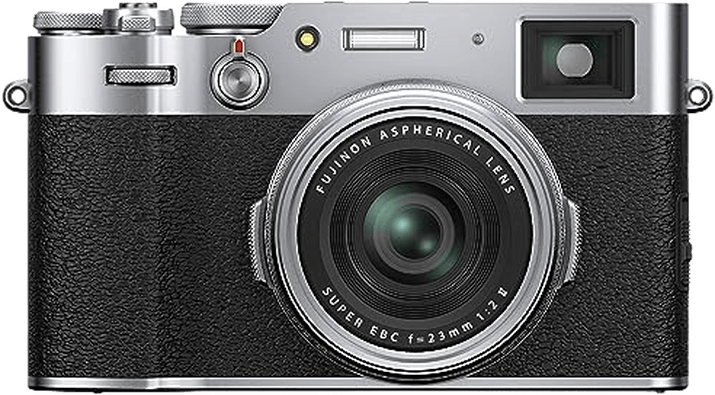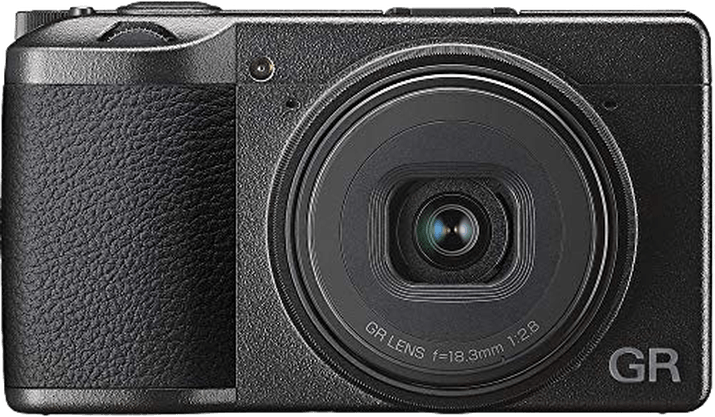Fujifilm X100V vs Ricoh GR III Comparison
Fujifilm X100V

Ricoh GR III

The Fujifilm X100V outperforms the Ricoh GR III with a score of 69/100 compared to 66/100. Both cameras share similarities, such as being lightweight and compact, with the X100V weighing 478g and the GR III at 257g. However, the X100V, a mirrorless camera, is larger in size (128 x 75 x 53mm) than the compact GR III (109 x 62 x 33mm).
The X100V excels with its higher score and recent release in 2020, offering a more advanced camera experience. On the other hand, the GR III, released in 2018, has a lower launch price of $899, making it more affordable.
Considering these factors, the Fujifilm X100V is the better option for those seeking a more advanced camera, while the Ricoh GR III is suitable for budget-conscious buyers.
Fujifilm X100V vs Ricoh GR III Overview and Optics
The Ricoh GR III wins the optics comparison with a score of 68/100, while the Fujifilm X100V scores slightly lower at 66/100. Both cameras share some common specifications, such as having a CMOS sensor, APS-C sensor size, and fixed lens mounts.
The Fujifilm X100V has a higher megapixel count at 26, compared to the Ricoh GR III’s 24 megapixels. This results in slightly better image resolution and detail. Additionally, the X100V has a faster shooting speed of 11 frames per second, making it more suitable for capturing fast-moving subjects or action shots. The camera also boasts an X-Processor 4, which contributes to its overall performance and image quality.
On the other hand, the Ricoh GR III has a few advantages over the Fujifilm X100V. Firstly, it has image stabilization, which helps reduce the effects of camera shake and results in sharper images, especially in low-light situations or when using slower shutter speeds. The GR III also has a DXOMARK sensor score of 76, indicating a strong performance in areas such as color depth, dynamic range, and low-light ISO. However, it is important to note that DXOMARK does not score Fujifilm cameras, so a direct comparison of sensor scores between the two cameras is not possible. The Ricoh GR III also features a GR Engine 6 processor, which aids in its overall image processing capabilities.
In conclusion, the Ricoh GR III narrowly wins the optics comparison due to its image stabilization feature and strong sensor performance. However, the Fujifilm X100V remains a strong contender with its higher megapixel count and faster shooting speed, making it a suitable choice for those prioritizing resolution and action photography.
Fujifilm X100V vs Ricoh GR III Video Performance
The Fujifilm X100V outperforms the Ricoh GR III in video capabilities, scoring 91/100 compared to the GR III’s 70/100. Both cameras share the useful feature of built-in time-lapse functionality, but the similarities end there.
The X100V boasts a maximum video resolution of 4K, with dimensions reaching 4096 x 2160. This vastly surpasses the GR III’s Full HD maximum video resolution, which only offers dimensions of 1920 x 1080. Furthermore, the X100V’s maximum video frame rate is 120fps, doubling the GR III’s 60fps. The combination of higher resolution and faster frame rate allows the X100V to produce smoother, more detailed video footage.
While the GR III lags behind in overall video performance, it still holds its own in certain situations. For users who prioritize compactness and portability, the GR III’s smaller size may be a more attractive option. However, this advantage does not outweigh the superior video capabilities of the X100V.
When comparing the Fujifilm X100V and the Ricoh GR III, the X100V is the clear winner in terms of video performance. With 4K resolution, larger video dimensions, and a faster frame rate, the X100V provides superior quality and versatility. The GR III’s main advantage lies in its compact size, but this does not compensate for its lower video capabilities. Therefore, users who prioritize video performance should opt for the Fujifilm X100V.
Fujifilm X100V vs Ricoh GR III Features and Benefits
The Fujifilm X100V outperforms the Ricoh GR III in terms of features, scoring 85 out of 100 points, compared to the Ricoh’s 70 points. Both cameras share some common specifications, but the X100V has distinct advantages that contribute to its higher score.
Both the X100V and GR III have a 3-inch screen and touchscreen capabilities. They also both lack GPS, but offer WIFI and Bluetooth connectivity. Despite these similarities, the X100V has a higher screen resolution of 1,620,000 dots, while the GR III has a resolution of 1,037,000 dots. This higher resolution provides the X100V with a clearer and more detailed display.
Another advantage of the X100V is its flip screen, which the GR III does not have. This feature allows for more flexible shooting angles and improved usability, particularly for capturing images from low or high perspectives.
The Ricoh GR III, although scoring lower in features, has its own merits. However, these advantages are not related to the features listed, and therefore do not contribute to a higher score in this comparison.
In conclusion, the Fujifilm X100V surpasses the Ricoh GR III in terms of features, primarily due to its higher screen resolution and the presence of a flip screen. These advantages make the X100V a more versatile and user-friendly option. Meanwhile, the Ricoh GR III has its own strengths, but they do not impact its feature score in this comparison.
Fujifilm X100V vs Ricoh GR III Storage and Battery
The Fujifilm X100V wins the storage and battery comparison with a score of 37/100, while the Ricoh GR III scores 27/100. Both cameras have a single memory card slot, accepting SD, SDHC, and SDXC cards (UHS-I compatible). They also both offer USB charging capabilities.
The X100V outperforms the GR III in battery life, providing 420 shots per charge compared to the GR III’s 200 shots. This difference is due to the X100V’s use of the NP-W126S battery, which is more efficient than the GR III’s DB-110 battery.
However, the GR III has an advantage in storage options as it includes internal storage in addition to the memory card slot. This feature can be useful for photographers who require extra storage in a pinch.
Considering these factors, the Fujifilm X100V is the better choice for photographers who prioritize longer battery life, while the Ricoh GR III may appeal to those who value the added internal storage option.
Fujifilm X100V vs Ricoh GR III – Our Verdict
Are you still undecided about which camera is right for you? Have a look at these popular comparisons that feature the Fujifilm X100V or the Ricoh GR III:

